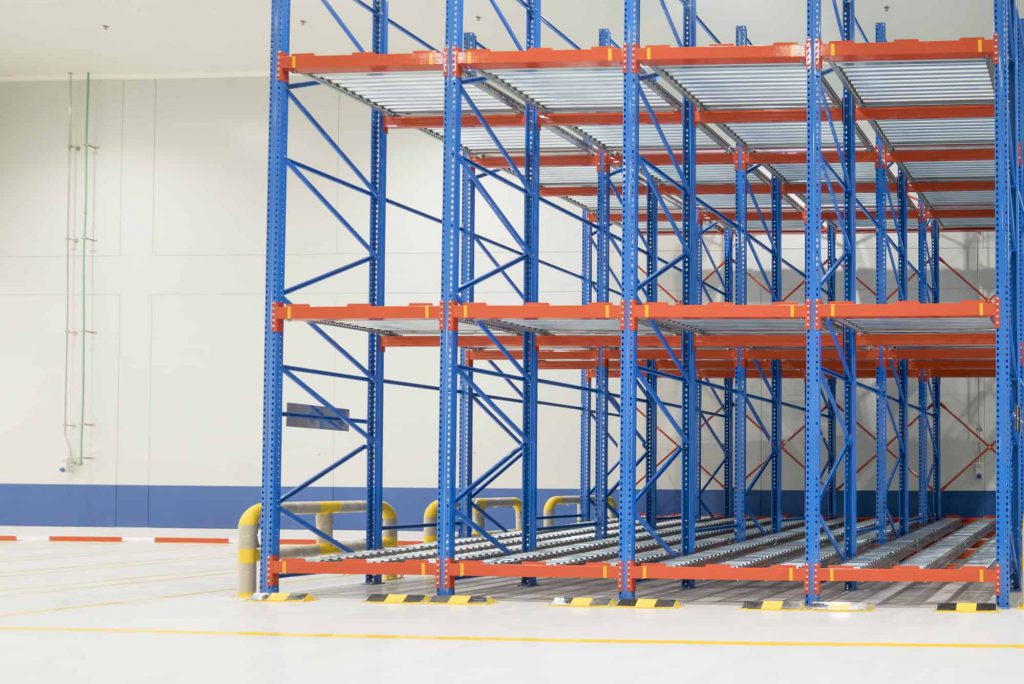Expert warehouse managers know there are myriad different kinds of pallet racking types. And they integrate into a variety of systems, profiles, setups, and designs. Knowing which form is the best for your function is critical to operational success.
Here is a breaking down the main pallet racking types. Take a look at these different styles and compare them against your space requirements and logistics. Then, you’ll be well on your way toward a configuration that delivers on performance expectations.
1. Selective Racking
A selective racking system consists of three major parts: uprights, footplates, and beams.
It’s the most common system in the materials handling industry, and for good reason. This type of pallet racking has a design is flexible enough to accommodate almost any kind of forklift equipment, as well as many different types of loads.
Though its storage capacity is lower than other models, it makes up for it in affordability. Selective racking systems offer the lowest cost per unit stored of any option.
To ensure 100% selectivity and access to every pallet in storage, this rack system is only one pallet deep. This enables First In First Out (FIFO) inventory management that ensures turnover for perishable SKUs or those with a short shelf life.
2. Double Deep Pallet Racking
For warehouses that prioritize storage capacity over quick handling, double deep pallet racking is ideal. This setup mimics selective racking, but instead of only being one pallet deep, it consists of a maximum of two racks, with one stored behind the other.
Accessing these pallets requires a special forklift rather than a normal reach truck. Keep in mind that you’ll only be able to access the second pallet once the first is gone unless you’re operating a forklift that features a telescopic fork or pantograph.
As such, double deep pallet racking is best suited for multiple pallets that share the same SKU. When used, however, this setup lowers the number of aisles needed to access your loads and can enhance functionality.
3. Push Back Racking
When fully loaded, a push back racking system appears to be a selective rack.
Yet, further inspection reveals that it’s more akin to a double deep pallet rack, though it allows warehouse workers to store pallets up to seven deep on either side of an aisle.
The advantage of this design? It boosts storage density without requiring a special forklift for access. Rather, this style uses inclined rails and a series of nesting carts.
The forklift will load the first pallet on the top cart. When the operator adds a second pallet, it pushes that first pallet back and rests the second one on the middle cart. From there, the third pallet pushes the other two back and sits on the bottom cart.
Thus, this setup works best with First In, Last Out (FILO) storage and isn’t suited for time-sensitive SKUs.
4. Deep Lane Pallet Racking
When you’re working with a substantial amount of pallets, you need a pallet racking design that delivers. A deep lane pallet racking setup allows you to store anywhere from six to more than 100 pallets as deep and high as you need.
When they’re all in one spot, this eliminates the need for bulky and time-consuming forklift pallet transport. Instead, you can leverage a Pallet Shuttle System to store and transport time-sensitive products or consolidate outbound loads at the shipping dock.
This technology can collect or stack the pallet via remote control. This makes level-by-level handling a cinch and allows you to store different SKUs in the same section. The layout works for both FIFO and LIFO (Last In, First Out) inventory management.
5. Drive-In Racking
In warehouses that support a large number of pallets per SKU, it’s often easiest to design a drive-in racking system. Rather than accessing, loading and transporting each pallet at each separate rack site, the forklift operator will drive through the rack structure itself to pick up or drop off each load.
This helps to eliminate wasted aisle space and improves overall warehouse efficiency. The only drawbacks? Operators can only select those pallets that face the aisle and storage density is limited.
Warehouse managers can select from between drive-in racking and drive-through racking. The former allows operators to access racks from one side, while the latter allows access from either side of the rack.
6. Pallet Flow Racking
If you manage a high-velocity operation, pallet flow racking can help you organize your SKUs into a manageable storage system.
Designed for FIFO setups, this system revolves around an operator who adds each pallet at the loading end of an inclined rack. From there, the pallets glide at a controlled rate to the discharge end. As a result of this slope, the loading end raises as more pallets load.
This design encourages optimal product turnover and is ideal for time-sensitive materials.
7. Cantilever Racking
Like the idea of selective racking, but think your load is too long to handle it? This is where cantilever racking comes in.
Also known as long load storage, it’s made to support loads that are greater than 12 feet long. This system provides 100% selectivity and can support a range of load types.
The load-carrying arms extend from a single column, without a front column to block or limit storage capacity. This provides total horizontal access, eliminates lost storage space, and improves handling clearance.
Find the Pallet Racking Types Your Warehouse Needs
The ideal racking setup for your organization will hinge on a few different factors. From space considerations to access requirements, take the time to research the layout that will make the best use of your existing resources.
From there, you’ll be able to find the pallet racking types that make the most sense for your warehouse.
Need a little help along the way? That’s why we’re here.
We’re your go-to resource for racking, pallet, and storage items. Contact us today to learn more. We can help you design a system that exceeds performance expectations.

